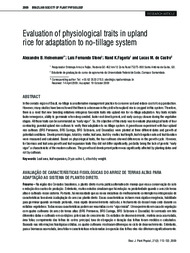Evaluation of physiological traits in upland rice for adaptation to no-tillage system.
Evaluation of physiological traits in upland rice for adaptation to no-tillage system.
Autoria: HEINEMANN, A. B.; STONE, L. F.; FAGERIA, N. K.; CASTRO, L. M. de
Resumo: In the cerrado region of Brazil, no-tillage is an alternative management practice to conserve soil and reduce cost of crop production. However, many studies have been showed that there is a decrease in the yield when upland rice is cropped in this system. Therefore, there is a need that new breeding initiatives introgress favorable traits into upland rice for no-tillage adaptation. Key traits include faster emergence, ability to germinate when deep seeded, faster root development, and early canopy closure during the vegetative stages. All those traits can be summarized as "early vigor". So, the objective of this study was to evaluate physiological traits of four contrasting parental upland rice cultivars to verify their adaptation to no-tillage system. A greenhouse experiment with four upland rice cultivars (BRS Primavera, BRS Curinga, BRS Soberana, and Douradão) were planted at three different dates and growth at potential conditions. Development stages, total dry matter, leaf area, leaf dry matter, leaf length, leaf elongation rate and leaf duration were measured and calculated. Based on physiological traits, the four cultivars showed differences in the growth cycle. However, for biomass and leaf area growth and leaf expansion traits they did not differ significantly, probably being the lack of genetic "early vigor" a characteristic of the modern cultivars. The growth and development pattern was significantly affected by planting dates and not by cultivars.
Ano de publicação: 2009
Tipo de publicação: Artigo de periódico
Unidade: Embrapa Arroz e Feijão
Palavras-chave: Arroz, Biomassa, Cerrado, Expansão de folhas, Oryza sativa, Plantio direto, Área foliar
Observações
1 - Por padrão são exibidas publicações dos últimos 20 anos. Para encontrar publicações mais antigas, configure o filtro ano de publicação, colocando o ano a partir do qual você deseja encontrar publicações. O filtro está na coluna da esquerda na busca acima.
2 - Para ler algumas publicações da Embrapa (apenas as que estão em formato ePub), é necessário ter, no celular ou computador, um desses softwares gratuitos. Sistemas Android: Google Play Livros; IOS: iBooks; Windows e Linux: software Calibre.
Acesse outras publicações
Acesse a Base de Dados da Pesquisa Agropecuária (BDPA) para consultar o acervo completo das bibliotecas da Embrapa.

